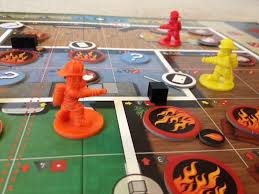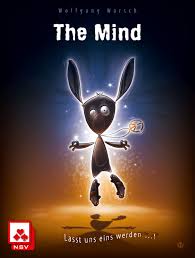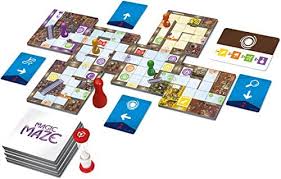Game Mechanics: How to Make a Compelling Co-op Game
In the first article in this series on game mechanics, we talked about creating tension in your game and I mentioned a few co-op games that do this well. Today’s article will be all about implementing the right game mechanics to make a compelling co-op game (short for co-operative game), which often also involve some sort of tension.
I’m going to borrow a great concept that I heard my friend Peter Hayward discuss on the Board Game Design Lab Podcast, which is a good co-op game generally fits into one of the following two categories:
- A game with a winning condition that competes with losing conditions for your attention (the need to “put out fires”)
- Limited communication
We’re going to explore this further, in the direction of what mechanics have been and can be utilized to make a great co-op game.
Co-op Games with Competing Winning and Losing Conditions
In the introduction to this topic, I mentioned the need to “put out fires”, which could be figurative as is the case of a game like Forbidden Desert or Spirit Island, or quite literally, as you must do as firefighters in Flashpoint: Fire Rescue.
Most of the great co-op games set a challenging goal that you must complete to win, but also multiple losing conditions as well.
The winning conditions might be to cure all diseases (Pandemic), capture all 4 treasures and get off the island (Forbidden Island), or save all the residents in a burning building (Flashpoint: Fire Rescue).

The losing conditions can be many, including running out of cards, having a meter that hits the endpoint, running out of components to place, or one of many other conditions.
One of the main game mechanics you’ll see used in many co-op games is action point selection.
Players are given a specific number of “points” they can allocate towards the actions they need to take to accomplish their goals and prevent defeat. Often it will be a one-for-one transaction, such as the ability to move, trade cards, explore, hand in cards, etc. for one action each. However, sometimes an action will take more than one action point to pull off.
Players must decide individually and collectively how to make the best use of these action points.
Players will also often have individual player powers, which allows them to do something that no other player can do, such as move other players, complete an action multiple times for only one action point, reduce a requirement, or some other power. These asymmetrical player abilities allow for more variation and the fun of trying out different roles and combinations.
Players will often have to roll dice or draw cards from a deck to trigger events, some of which are helpful and some of which increase the tension and bring the team one step closer to defeat.
A deck of cards will often also act as a timer of sorts (as in Pandemic), ending the game in defeat if it ever runs out.
As you can see, many different game mechanics are often used in combination to create feelings of tension and setting up multiple ways to lose the game.
Co-op Games with Limited Communication
The other way that good co-op games are created is through limited communication. This can be accomplished by players not being able to talk (or only in limited ways or at specific times) or through the use of time pressure, where there is little time to plan or discuss options.
A good example of a game where players cannot talk or communicate in any manner is The Mind.

In The Mind, players are dealt some cards with values ranging from 1 to 100 in their hand and must play them in sequential order. But how do you do this without letting others know what you have? You have to get on the same wavelength.
If any card is played out of sequence, you lose a life, which you only have a limited number of, and if you run out, game over. However, you can gain lives, as well as shuriken cards throughout the game that will allow all players to discard their lowest card simultaneously without penalty. This is a good risk and luck mitigation strategy.
Hanabi on the other hand is a card game where you actually face your cards outwards so that only other players can see them, but not yourself.

In this game, you must also try to play cards in sequential order, but additionally, you must play them by colour. You must give each other clues but can only say a colour or number. This limited communication makes this a tricky game to master.
Other co-op games make use of a timer to create tension and limit your communication simply because you don’t have time to discuss elaborate strategies.
One example of this is a game I’ve mentioned before, Escape: Curse of the Temple. In this game, you are rolling dice as fast as you can open new rooms, collect treasures, and escape before time runs out.
Magic Maze is another game in this vein, where players must collectively move 4 pawns to their item spaces and escape in time, but the rules only allow players to communicate by setting a marker in front of the player you want to take an action. The only time you can talk is when you reach a safe space and flip the sand timer over. But as soon as you move off this space, silence commences.

Games like Magic Maze and Escape: Curse of the Temple also do a good job of reducing the alpha player problem, which happens when one player tries to dictate what other players should do. You want collaboration in a co-op game, not a dictatorship, and these games ensure collaboration, as players must control their own actions, while there is little time for players to do what they need to do.
You can see that by limiting or removing communication altogether, you create a different experience, one that can make for a very challenging co-op game.
What’s your favourite co-op game and why?
Please leave a comment and share your thoughts.
Next week we’ll be looking at how to create a great solo gaming experience.
Whether you’re making a co-op, competitive, or solo game, my FREE 10 Minute Board Game Design Blueprint will help guide you along the way.

7 comments
Jesse Fernandez
I don’t have any co-op games in my small collection of games other than playing a Pathfinderor D&D game but that’s been 3 years ago. So I wouldn’t know of any other than the ones you have mentioned in your post. I do have 2 games I have designed for co-op though they are not published yet.
Bill Murphy
Hi, I like Sub Terra. It is an exploration game and the abilities on the different characters make for good replay value. Also Each player can help with the group and usually work better if used to help the group and not so much themselves. Much like Pandemic, that I also like. Interesting about Sub Terra is that if you get at least 1 character out you win at the lowest level. You never rally loose. If all characters get out you win at the highest level. You want to play again and again to increase your win level and do better than the group did last time.
Ferdy H.
I am working towards a game that is coopetition. Players work together by making sure the possible points to be scored are in their team. However they try to score the points themselves. How do you guys see this kind of coop element fitting in the two categories? And what do you think of the issue of making games like this but with less than the minimum (4 players – 2v2)?
Joe Slack
Hi Ferdy. It sounds like your game might be considered “semi-cooperative”. There are other games like this, including the very popular Dead of Winter. In games of this nature, you have to work together, but you are also trying to win on your own. They can certainly be team-based or one vs. many or any other configuration.
Check out some other semi-cooperative games that might help with inspiration: https://boardgamegeek.com/boardgamemechanic/2820/semi-cooperative-game
David Collins
Great article Joe. Would you say any of those games you mentioned excel as a two-player co-op game?
I’m designing a co-op game and building on the multiple lose conditions by having “different levels” of win/lose.
Joe Slack
Thanks, David. I would say that I’ve played almost all the games I mentioned as two-player as well as with larger groups (and many of them solo as well!). I wouldn’t say any of them excelled with two players, but all of them play very well with any player count I have tried.
How to create an amazing co-op game (discover the 2 types)
[…] I also talk about these games in this article. […]